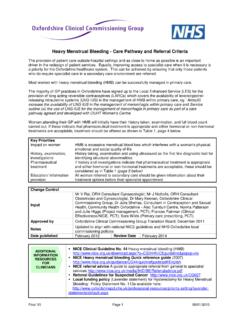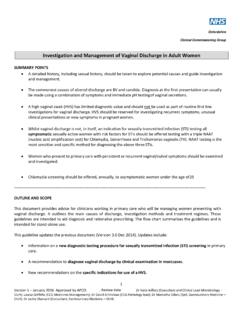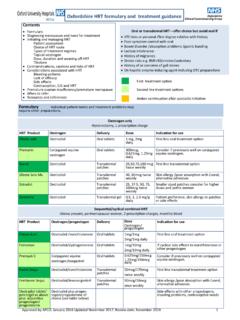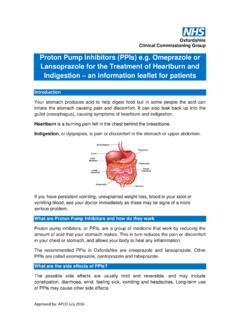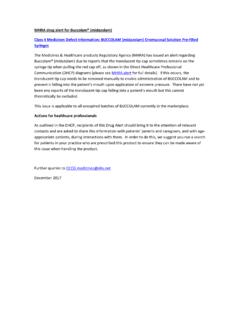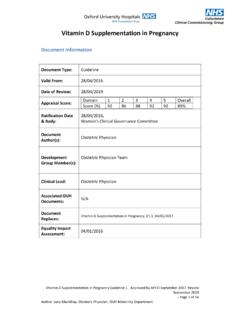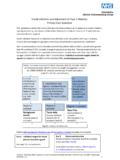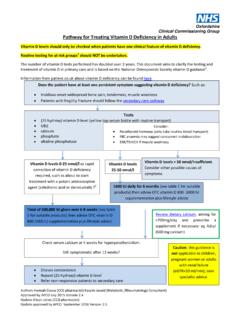Transcription of Primary Care Prescriber Decision Support for Direct Oral ...
1 Primary Care Prescriber Decision Support for DOACs for stroke prevention in Atrial Fibrillation Approved by APCO January 2016. Review January 2019. Primary Care Prescriber Decision Support for Direct Oral Anticoagulants DOACs for Stroke Prevention in Atrial Fibrillation Oxfordshire Clinical Commissioning Group The patient has AF and using the CHA2DS2-VASc and HAS-BLED score the Decision has been made to anticoagulate. Anticoagulants continue to be under-prescribed because of a perceived underestimation of the benefits and an over estimation of the risks particularly the risk of bleeding. Patients on any type of anticoagulant will need education ( ). This is automatically provided through the anticoagulation clinic for patients initiated on warfarin.
2 Community pharmacists can provide education under the New Medicine Service. Does the patient have any of the following? Moderate-severe mitral stenosis (usually due to rheumatic heart disease) Mechanical heart valve CrCl<30ml/min (local advice see summary table below) Refer to anticoagulation clinic for initiating warfarin therapy Warfarin OR DOAC? Establish which anticoagulants would be appropriate. Consider patient characteristics. Yes No Discuss relative risks and benefits of each agent with patient so that informed Decision can be made, and provide patient information. Prescribe the selected anticoagulant If warfarin, refer to OUHFT Anticoagulant Clinic If DOAC, the GP is responsible for ongoing monitoring and follow up Primary Care Prescriber Decision Support for DOACs for stroke prevention in Atrial Fibrillation Approved by APCO January 2016.
3 Review January 2019. Choice of anticoagulant therapy The Decision about whether to start treatment with warfarin or a DOAC (formerly NOAC) should be made after an informed discussion between the Prescriber and the patient about the relative risks and benefits of each agent. There are many factors to consider when recommending an anticoagulant. For example indication, bleeding risk, drug interactions, renal and liver function, lifestyle issues, alcohol consumption, poor compliance, failure to comply with monitoring arrangements etc. Key points for warfarin Has been prescribed for more than 50 years. Warfarin activity/effect can be measured by an INR and may help give an indication to compliance. Effective antidote (prothrombin complex concentrate). Warfarin steady state can take at least a week, but patients are often not therapeutic until 2-3 weeks into therapy if loaded slowly.
4 Warfarin has many drug-drug and certain food interactions which may require additional INR monitoring. Patients may have difficulty around INR monitoring. Correct INR can be difficult to manage despite good compliance in some patients. Patient needs regular follow up and blood sampling. Cannot be put in a dosette box unless risk assessment has been done and a management plan is in place to manage dose adjustment. Warfarin and coagulation factors have long half-lives and therefore missed doses result in less loss of anticoagulation compared to DOACs. For patients with IHD, ACS or stents follow Cardiology advice regarding use of antiplatelets. Key points for DOACs Compared to warfarin DOACs are relatively new to market. No requirement for INR monitoring.
5 Compared with warfarin all have a reduced risk of intracranial haemorrhage. Idarucizumab is licensed and NICE-approved for dabigatran reversal in adult patients when rapid reversal of its anticoagulant effects is required. There is currently no licensed antidote in the reversal of anticoagulant effect of rivaroxaban, apixaban and edoxaban (although products are available to help counteract the anticoagulant effect, such as tranexamic acid and prothrombin complex concentrate). Immediate anticoagulant effect (time to peak effect ranges from 1-4 hours). DOACs currently have no known food interactions. Useful for patients who have difficulty getting INR measured. Minimum of U&E and LFT annually. Renal function should be assessed and monitored using Cockcroft and Gault formula Creatinine Clearance (CrCl), especially in patients with extreme BMI.
6 Useful for patients with erratic INR not due to non-compliance. Apixaban, edoxaban and rivaroxaban are stable in a dosette box and so useful for patients who need external Support to take medicines. Primary Care Prescriber Decision Support for DOACs for stroke prevention in Atrial Fibrillation Approved by APCO January 2016. Review January 2019. DOACs have short half-life and so missed doses will have greater loss of anticoagulation than warfarin. For patients with IHD, ACS or stents follow Cardiology advice regarding use of antiplatelets. Patient groups considered to benefit from warfarin include: Patients with a history of poor compliance with medication which cannot be improved in the foreseeable future. Serious consideration should be given to whether these patients are suitable for any oral anticoagulation and whether supervised administration of low molecular weight heparin (LMWH) is preferable.
7 Patients with a weight of more than 120 kg. Contraindications to DOACs: o Severe renal impairment (dabigatran CrCl <30 mL/min, rivaroxaban, apixaban and edoxaban CrCl <15 mL/min). o Hepatic impairment (elevated liver enzymes >2 x ULN). o Interacting drugs with DOACs. o Intolerance or depending on the severity of reaction an allergy to a previous DOAC. Patients that consider warfarin as their preferred anticoagulant following an informed discussion with a clinician on the risks, benefits, individual circumstances and needs. Patient groups considered to benefit from a DOAC include: Those with poor INR control on warfarin despite good compliance. Significant difficulties with INR monitoring. Patients in whom warfarin is unsuitable due to allergy or intolerance alopecia.
8 Those with recurrent changes in medicines such as antibiotics. Those with monitored dosage systems (MDS) (an exception is dabigatran as this is not suitable for use in an MDS). Patients that consider a DOAC as their preferred anticoagulant following an informed discussion with a clinician on the risks, benefits, individual circumstances and needs. Primary Care Prescriber Decision Support for DOACs for stroke prevention in Atrial Fibrillation Approved by APCO January 2016. Review January 2019. Table of considerations when deciding which DOAC for which patient Patient characteristics Which anticoagulant? Rationale Mechanical valve or moderate to severe mitral stenosis Warfarin DOACs are contraindicated High risk of bleeding or patients concern about bleeding Apixaban Dabigatran 110mg Edoxaban Reduce risk of bleeding compared to warfarin with apixaban, dabigatran 110mg and edoxaban.
9 History of GI bleed Apixaban Dabigatran 110mg Warfarin Higher rates of GI bleeding with dabigatran 150mg, rivaroxaban and edoxaban compared to warfarin. Dyspepsia Apixaban Rivaroxaban Warfarin Edoxaban Dyspepsia was occurs in 10% of patients on dabigatran High risk of ischaemic stroke and age < 80 years Dabigatran 150mg Dabigatran 150mg bd is the only DOAC shown to be superior to warfarin in reducing ischaemic stroke Renal impairment CrCl <30ml/min Warfarin DOACs not recommended. Apixaban is the least renally cleared. See summary table below for more detail. Liver impairment AST/ALT >2 x ULN Warfarin Warfarin is preferred. See summary table below for more detail. Once a day formulation preferred Edoxaban Rivaroxaban Warfarin Rivaroxaban and edoxaban are both once a day administration Requirement for a compliance aid (weekly monitored dosage systems filled by pharmacy, or weekly tablet organiser filled by patient, Nomad, Dosette, etc) Apixaban Edoxaban Rivaroxaban Dabigatran must be kept in the original packaging with desiccant, therefore is not suitable for use in compliances aids or weekly pill organisers.
10 Warfarin cannot be put in a dosette box unless risk assessment has been done and a management plan is in place to manage dose adjustment. Swallowing difficulties or requiring administration through gastric tubes Apixaban Rivaroxaban Warfarin Apixaban tablets may be crushed and suspended in water or apple juice or mixed with apple puree and immediately administered orally. Apixaban may also be given through gastric tubes. Rivaroxaban can be crushed and mixed with water or apple puree immediately prior to oral administration. The dose should be immediately followed by food. Rivaroxaban may also be given through gastric tubes. Most brands of warfarin tablets will disperse in water within 5 minutes if shaken; the resulting dispersion flushes easily via a fine bore feeding tube without blockage.
